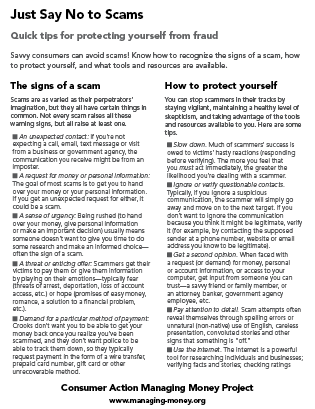Just Say No to Scams (Quick Tips)
Quick tips for protecting yourself from fraud
The Just Say No to Scams “quick tips" sheet provides consumers with the basics of recognizing the signs of a scam, understanding how to protect themselves and knowing where they can learn more.

Publication Series
- This publication is part of the Scams training module.
Download File
PDF files may contain outdated links.
Just Say No to Scams (Quick Tips)
File Name: ScamsQuickTips_2018_EN.pdf
File Size: 0.06MB
Languages Available
Table of Contents
Savvy consumers can avoid scams! Know how to recognize the signs of a scam, how to protect yourself, and what tools and resources are available.
The signs of a scam
Scams are as varied as their perpetrators’ imagination, but they all have certain things in common. Not every scam raises all these warning signs, but all raise at least one.
- An unexpected contact: If you’re not expecting a call, email, text message or visit from a business or government agency, the communication you receive might be from an imposter.
- A request for money or personal information: The goal of most scams is to get you to hand over your money or your personal information. If you get an unexpected request for either, it could be a scam.
- A sense of urgency: Being rushed (to hand over your money, give personal information or make an important decision) usually means someone doesn’t want to give you time to do some research and make an informed choice—often the sign of a scam.
- A threat or enticing offer: Scammers get their victims to pay them or give them information by playing on their emotions—typically fear (threats of arrest, deportation, loss of account access, etc.) or hope (promises of easy money, romance, a solution to a financial problem, etc.).
- Demand for a particular method of payment: Crooks don’t want you to be able to get your money back once you realize you’ve been scammed, and they don’t want police to be able to track them down, so they typically request payment in the form of a wire transfer, prepaid card number, gift card or other unrecoverable method.
How to protect yourself
You can stop scammers in their tracks by staying vigilant, maintaining a healthy level of skepticism, and taking advantage of the tools and resources available to you. Here are some tips.
- Slow down. Much of scammers’ success is owed to victims’ hasty reactions (responding before verifying). The more you feel that you must act immediately, the greater the likelihood you’re dealing with a scammer.
- Ignore or verify questionable contacts. Typically, if you ignore a suspicious communication, the scammer will simply go away and move on to the next target. If you don’t want to ignore the communication because you think it might be legitimate, verify it (for example, by contacting the supposed sender at a phone number, website or email address you know to be legitimate).
- Get a second opinion. When faced with a request (or demand) for money, personal or account information, or access to your computer, get input from someone you can trust—a savvy friend or family member, or an attorney, banker, government agency employee, etc.
- Pay attention to detail. Scam attempts often reveal themselves through spelling errors or unnatural (non-native) use of English, careless presentation, convoluted stories and other signs that something is "off."
- Use the internet. The internet is a powerful tool for researching individuals and businesses; verifying facts and stories; checking ratings and reviews; comparing prices; and accessing scam-fighting tips and resources. If you don’t have online access, get help from someone who does, or access the internet at your public library.
- Use a credit card. Credit cards offer strong consumer protections under federal law—the right to dispute a fraudulent transaction, for example, and a $50 limit on your liability for unauthorized charges—and payments are traceable.
- Stay on top of the latest scams. Reading scam-related news helps you not only avoid new scams, it keeps you on your toes and helps you develop a "sixth sense" for spotting fraud.
Resources
Just Say No to Scams: A guide to protecting yourself from liars, cheats and crooks is available for free download from the Consumer Action website.
Common Scams: Recognizing and avoiding fraud, a compilation of dozens of common scams, including advice for avoiding or responding to each one, is available for free download from the Consumer Action website.
SCAM GRAM is Consumer Action’s monthly email alerting you to the dirtiest players in the world of tech fraud, credit card scams, ID theft and general con-artistry.
Fraud.org alerts help you stay ahead of trending scams.
Better Business Bureau’s (BBB) Scam Tracker allows you to report a scam and read about other consumers’ reported scams, all with the goal of foiling future attempts.
Federal Trade Commission (FTC) scam alerts provide the latest information and practical tips from the nation’s consumer protection agency.
IdentityTheft.gov offers a recovery plan for victims of identity theft.
Published / Reviewed Date
Published: June 24, 2018
Download File
Just Say No to Scams (Quick Tips)
File Name: ScamsQuickTips_2018_EN.pdf
File Size: 0.06MB
Sponsors
Notes
This guide was created by Consumer Action’s Managing Money Project.
Filed Under
Fraud/Scams ♦ ID Theft ♦ Internet ♦ Elder Fraud ♦
Copyright
© 2018 –2024 Consumer Action. Rights Reserved.



